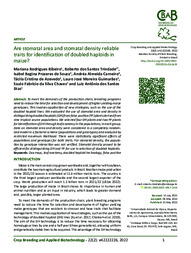Are stomatal area and stomatal density reliable traits for identification of doubled haploids in maize?
Are stomatal area and stomatal density reliable traits for identification of doubled haploids in maize?
Author(s): RIBEIRO, M. R.; TRINDADE, R. dos S.; SOUZA, I. R. P. de; CARNEIRO, A. A.; AZEVEDO, T. C. de; GUIMARAES, L. J. M.; CHAVES, S. F. da S.; DIAS, L. A. dos S.
Summary: To meet the demands of the production chain, breeding programs need to reduce the time for selection and development of higher yielding maize genotypes. This involves application of new strategies, such as the use of the doubled haploid lines. We evaluated the use of stomatal area and density in distinguishing doubled haploids (DH) from false positive (FP) plants derived from nine tropical source populations. We selected four DH plants and two FP plants for identification of DH through leaf anatomy in the populations, in each group. Data on stomatal area and density were considered in a completely randomized model in a factorial scheme (populations and genotypes) and analyzed by restricted maximum likelihood. There were statistically significant effects of populations and genotypes for both traits. For stomatal density, the population by genotype interaction was not verified. Stomatal density proved to be efficient for distinguishing DH and FP for use in selection of doubled haploids.
Publication year: 2022
Types of publication: Journal article
Unit: Embrapa Maize & Sorghum
Observation
Some of Embrapa's publications are published as ePub files. To read them, use or download one of the following free software options to your computer or mobile device. Android: Google Play Books; IOS: iBooks; Windows and Linux: Calibre.
Access other publications
Access the Agricultural Research Database (BDPA) to consult Embrapa's full library collection and records.
Visit Embrapa Bookstore to purchase books and other publications sold by Embrapa.

